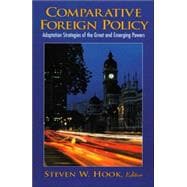
Note: Supplemental materials are not guaranteed with Rental or Used book purchases.
Purchase Benefits
What is included with this book?
STEVEN W. HOOK is Associate Professor of Political Science at Kent State University. His books include American Foreign Policy since World War II, with John Spanier (15th edition, 2000), National Interest and Foreign Aid (1995), and the anthology Foreign Aid toward the Millennium (1996). His authored and co-authored articles have been published in World Politics, International Studies Quarterly, Asian Survey, European Security, Democratization, and other journals. He is currently chair of the Foreign Policy Section of the American Political Science Association.
| Preface | ix | ||||
| About the Authors | xi | ||||
|
1 | (11) | |||
|
|||||
| Part I: Adaptation Strategies of the Great Powers | |||||
|
12 | (31) | |||
|
|||||
|
|||||
|
43 | (23) | |||
|
|||||
|
66 | (26) | |||
|
|||||
|
92 | (26) | |||
|
|||||
|
118 | (28) | |||
|
|||||
| Part II: Adaptation Strategies of the Emerging Powers | |||||
|
146 | (24) | |||
|
|||||
|
170 | (24) | |||
|
|||||
|
194 | (25) | |||
|
|||||
|
219 | (26) | |||
|
|||||
|
245 | (23) | |||
|
|||||
| Bibliography | 268 | (14) | |||
| Index | 282 |
The New copy of this book will include any supplemental materials advertised. Please check the title of the book to determine if it should include any access cards, study guides, lab manuals, CDs, etc.
The Used, Rental and eBook copies of this book are not guaranteed to include any supplemental materials. Typically, only the book itself is included. This is true even if the title states it includes any access cards, study guides, lab manuals, CDs, etc.